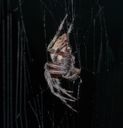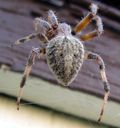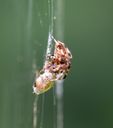Neoscona crucifera
Classification
- Phylum: Arthropoda
- Subphylum: Chelicerata
- Class: Arachnida
- Order: Araneae
- Infraorder: Araneomorphae
- Family: Araneidae
- Genus: Neoscona
- Species: crucifera
Pronunciation
How to pronounce Neoscona crucifera: //niːˈɒskə.nə ˌkruːsɪˈfɛrə//
These audio files are automatically generated. While they are not always 100% accurate, they are a good starting point.
Images






Summary
Neoscona crucifera, commonly known as the Hentz orbweaver or barn spider, is a significant orb-weaver spider found widely in North America, identified by its distinctive coloration and large webs.
Physical Characteristics
Females are about 9.5–19 mm (0.37–0.75 in) long, while males are smaller at 5–15 mm. The upper surface of the abdomen is brown and hairy, with rusty red or golden orange coloration being most common. The legs display alternating light and dark brown bands. The undersurface of the abdomen is black, marked with two white spots.
Identification Tips
Can usually be distinguished from Neoscona domiciliorum by rusty red color and lack of pattern on the abdomen.
Habitat
Found in various habitats including man-made structures, often constructing webs several feet above ground, particularly near outdoor lights.
Distribution
Found in the eastern United States from Maine to Florida, and from Minnesota to Arizona in the southwest, including southern California coastal communities and in Mexico.
Diet
Insects caught in their orb-shaped web, which they construct from silk.
Life Cycle
Eggs are laid in a fluffy yellow threads in a rolled leaf, with an egg mass measuring 5–12 mm in diameter containing up to 1,000 eggs.
Reproduction
Mating occurs in the spring or summer, and females often produce a large number of eggs in a single egg sac.
Predators
Juveniles are frequently preyed upon by mud daubers.
Ecosystem Role
As a spider, it plays a crucial role in controlling insect populations.
Cultural Significance
Commonly referred to as barn spider, but this name is also used for a different species, Araneus cavaticus.
Health Concerns
Might bite if provoked, but its venom is not dangerous to humans.
Misconceptions
The name 'barn spider' can refer to multiple species, leading to confusion.
Tags
- Arachnology
- Spider
- Neoscona crucifera
- Orb-weaver
- Hentz orbweaver
- Barn spider